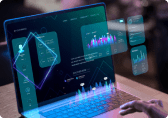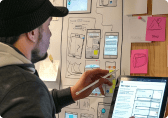
The Role of Data and Analytics In COVID-19 Response
How various data sources are being used to contain pandemics like COVID-19
AI at rescue
The whole world has taken a cue out of their book and is using AI-powered systems to detect the disease. The symptoms are weighted, for example, temperature, respiratory problems, etc. are scored and measured to understand and identify probable diseases.
IoT and social data
With the advent of IoT and the habits of people doing check-ins while travelling around became a blessing in disguise. Borrowing from the principles from how a communicable disease spreads, the spread of the coronavirus is also being predicted. Officials are able to predict which area will be affected so that the requisite logistics can be put in place for the quarantine. Analysis of parameters like travel history and the way the probable cases move around have become the key inputs.
Location Data
Today, the digital natives, extensively use google maps or GPS to move from one point to another and also use Facebook or Instagram to check in to the places they have been to. All this data is captured and tracked. It helps in case identification for the people who have travelled from the red zones and are probable carriers. What makes pandemics like COVID more dangerous is the fact that this virus stays asymptotic for a certain period of time. Using mobile data to track movement can also help identify those cases, which might have come in contact with the COVID infected person. Their whole travel history can be mapped with the probable subjects who might have shared the same flight, room, etc. with them during their sojourn, and can be quarantined.How data is being put to use
Border Control
Data management plays a significant role in border control. South Korea and Taiwan collected the names of the people travelling in the last couple of weeks at the onset of the pandemic and matched it with their health insurance aids. This was a step taken to control not only the identified cases, but also the asymptomatic people while they are stepping back into the country. They made this data available to all the hospitals so that no stone was left unturned to stop the pandemic.
Identify High-risk Patients
In poorer countries, it is difficult to identify the most vulnerable demography. Certain communities, find it challenging to adhere to the strict quarantine laws being laid down. It is doubly important to identify the most vulnerable subjects from there and isolate them. It is especially critical as they tend to live in highly congested areas. To manage such cases, in Kenya, a scorecard is prepared where cases are identified based on age, lifestyle issues (smoking, etc.), and a score is attached to identify potential victims.Resource Mobilisation
The fast-spreading pandemic forces authorities to mobilise their resources at an equal speed to monitor the cases and control the pandemic. Similar principles were applied during the swine flu era in the USA. Now, it has converted into the making of quarantine zones being available for the airports, which are the hotspots. Data analytics is being used to decide where to move the ventilators and gather insights to make the right infrastructure available at the required places.Targeted Communication
The principles of targeted communication are also being powered by AI and ML. The vulnerable communities are constantly being made aware of the threat and the care to be taken. AI is being used to analyse news reports, social media posts, and documents issued by government agencies to detect an outbreak and issue appropriate public warnings. AI-powered chatbots are also being used as essential communication tools.
Technologies like big data, analytics, AI, ML are not just the fancy terms of CXO discussions. These have a tremendous potential to make such a positive impact on the world – are you ready to explore those?

















